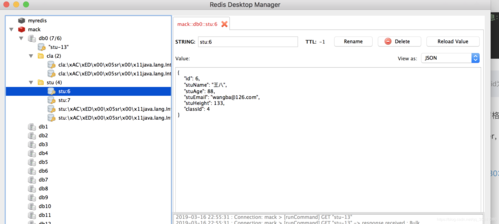
🏷️个人主页:牵着猫散步的鼠鼠
🏷️系列专栏:Java全栈-专栏
🏷️个人学习笔记,若有缺误,欢迎评论区指正
前些天发现了一个巨牛的人工智能学习网站,通俗易懂,风趣幽默,忍不住分享一下给大家。点击跳转到网站AI学习网站。
目录
前言
实现方案概述
具体实现方案
① 启动监听事件
② @PostConstruct 注解
③ ***mandLineRunner或ApplicationRunner
④ 实现InitializingBean接口
小结
编辑
前言
缓存预热是指在 Spring Boot 项目启动时,预先将数据加载到缓存系统(如 Redis)中的一种机制。
那么问题来了,在 Spring Boot 项目启动之后,在什么时候?在哪里可以将数据加载到缓存系统呢?
实现方案概述
在 Spring Boot 启动之后,可以通过以下手段实现缓存预热:
- 使用启动监听事件实现缓存预热。
- 使用 @PostConstruct 注解实现缓存预热。
- 使用 ***mandLineRunner 或 ApplicationRunner 实现缓存预热。
- 通过实现 InitializingBean 接口,并重写 afterPropertiesSet 方法实现缓存预热。
具体实现方案
① 启动监听事件
可以使用 ApplicationListener 监听 ContextRefreshedEvent 或 ApplicationReadyEvent 等应用上下文初始化完成事件,在这些事件触发后执行数据加载到缓存的操作,具体实现如下:
@***ponent
public class CacheWarmer implements ApplicationListener<ContextRefreshedEvent> {
@Override
public void onApplicationEvent(ContextRefreshedEvent event) {
// 执行缓存预热业务...
cacheManager.put("key", dataList);
}
}
或监听 ApplicationReadyEvent 事件,如下代码所示:
@***ponent
public class CacheWarmer implements ApplicationListener<ApplicationReadyEvent> {
@Override
public void onApplicationEvent(ApplicationReadyEvent event) {
// 执行缓存预热业务...
cacheManager.put("key", dataList);
}
}
② @PostConstruct 注解
在需要进行缓存预热的类上添加 @***ponent 注解,并在其方法中添加 @PostConstruct 注解和缓存预热的业务逻辑,具体实现代码如下:
@***ponent
public class CachePreloader {
@Autowired
private YourCacheManager cacheManager;
@PostConstruct
public void preloadCache() {
// 执行缓存预热业务...
cacheManager.put("key", dataList);
}
}
③ ***mandLineRunner或ApplicationRunner
***mandLineRunner 和 ApplicationRunner 都是 Spring Boot 应用程序启动后要执行的接口,它们都允许我们在应用启动后执行一些自定义的初始化逻辑,例如缓存预热。 ***mandLineRunner 实现示例如下:
@***ponent
public class My***mandLineRunner implements ***mandLineRunner {
@Override
public void run(String... args) throws Exception {
// 执行缓存预热业务...
cacheManager.put("key", dataList);
}
}
ApplicationRunner 实现示例如下:
@***ponent
public class MyApplicationRunner implements ApplicationRunner {
@Override
public void run(ApplicationArguments args) throws Exception {
// 执行缓存预热业务...
cacheManager.put("key", dataList);
}
}
***mandLineRunner 和 ApplicationRunner 区别如下:
-
方法签名不同:
- ***mandLineRunner 接口有一个 run(String... args) 方法,它接收命令行参数作为可变长度字符串数组。
- ApplicationRunner 接口则提供了一个 run(ApplicationArguments args) 方法,它接收一个 ApplicationArguments 对象作为参数,这个对象提供了对传入的所有命令行参数(包括选项和非选项参数)的访问。
-
参数解析方式不同:
- ***mandLineRunner 接口更简单直接,适合处理简单的命令行参数。
- ApplicationRunner 接口提供了一种更强大的参数解析能力,可以通过 ApplicationArguments 获取详细的参数信息,比如获取选项参数及其值、非选项参数列表以及查询是否存在特定参数等。
-
使用场景不同:
- 当只需要处理一组简单的命令行参数时,可以使用 ***mandLineRunner。
- 对于需要精细控制和解析命令行参数的复杂场景,推荐使用 ApplicationRunner。
④ 实现InitializingBean接口
实现 InitializingBean 接口并重写 afterPropertiesSet 方法,可以在 Spring Bean 初始化完成后执行缓存预热,具体实现代码如下:
@***ponent
public class CachePreloader implements InitializingBean {
@Autowired
private YourCacheManager cacheManager;
@Override
public void afterPropertiesSet() throws Exception {
// 执行缓存预热业务...
cacheManager.put("key", dataList);
}
}
小结
缓存预热是指在 Spring Boot 项目启动时,预先将数据加载到缓存系统(如 Redis)中的一种机制。它可以通过监听 ContextRefreshedEvent 或 ApplicationReadyEvent 启动事件,或使用 @PostConstruct 注解,或实现 ***mandLineRunner 接口、ApplicationRunner 接口,和 InitializingBean 接口的方式来完成。

